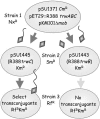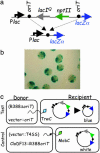Site-specific recombinase and integrase activities of a conjugative relaxase in recipient cells
- PMID: 16260740
- PMCID: PMC1283433
- DOI: 10.1073/pnas.0506081102
Site-specific recombinase and integrase activities of a conjugative relaxase in recipient cells
Abstract
Conjugative relaxases are the proteins that initiate bacterial conjugation by a site-specific cleavage of the transferred DNA strand. In vitro, they show strand-transferase activity on single-stranded DNA, which suggests they may also be responsible for recircularization of the transferred DNA. In this work, we show that TrwC, the relaxase of plasmid R388, is fully functional in the recipient cell, as shown by complementation of an R388 trwC mutant in the recipient. TrwC transport to the recipient is also observed in the absence of DNA transfer, although it still requires the conjugative coupling protein. In addition to its role in conjugation, TrwC is able to catalyze site-specific recombination between two origin of transfer (oriT) copies. Mutations that abolish TrwC DNA strand-transferase activity also abolish oriT-specific recombination. A plasmid containing two oriT copies resident in the recipient cell undergoes recombination when a TrwC-piloted DNA is conjugatively transferred into it. Finally, we show TrwC-dependent integration of the transferred DNA into a resident oriT copy in the recipient cell. Our results indicate that a conjugative relaxase is active once in the recipient cell, where it performs the nicking and strand-transfer reactions that would be required to recircularize the transferred DNA. This TrwC site-specific integration activity in recipient cells may lead to future biotechnological applications.
Figures



References
Publication types
MeSH terms
Substances
LinkOut - more resources
Full Text Sources
Other Literature Sources
Molecular Biology Databases

